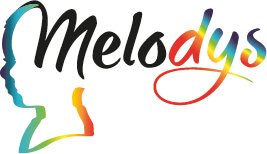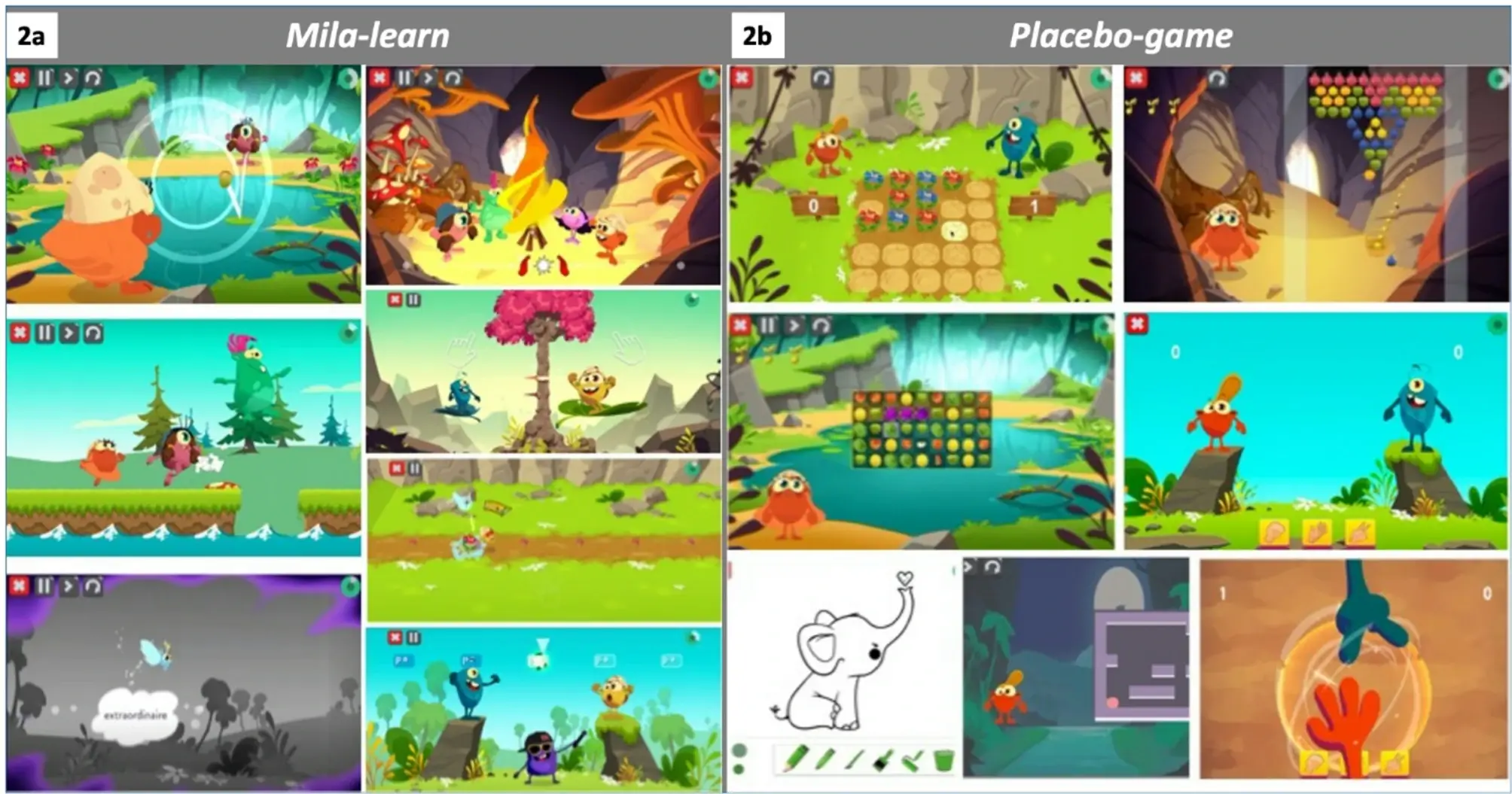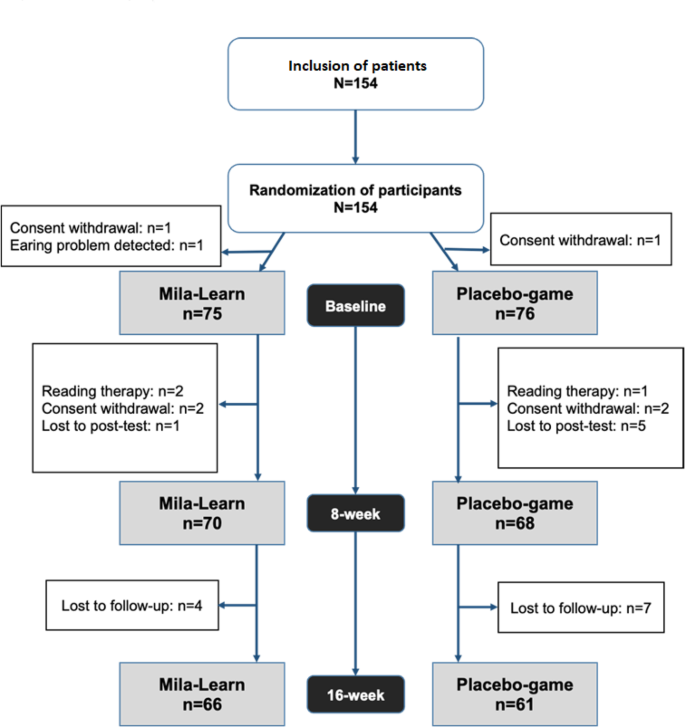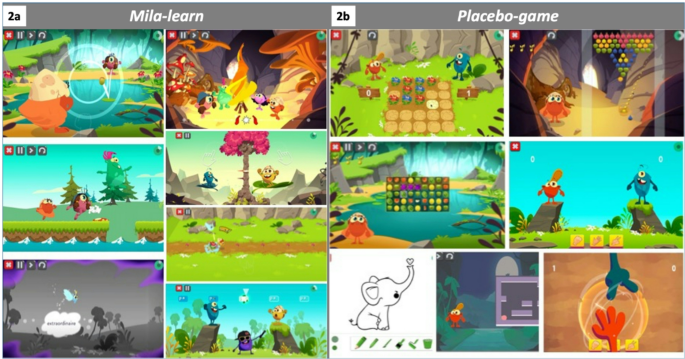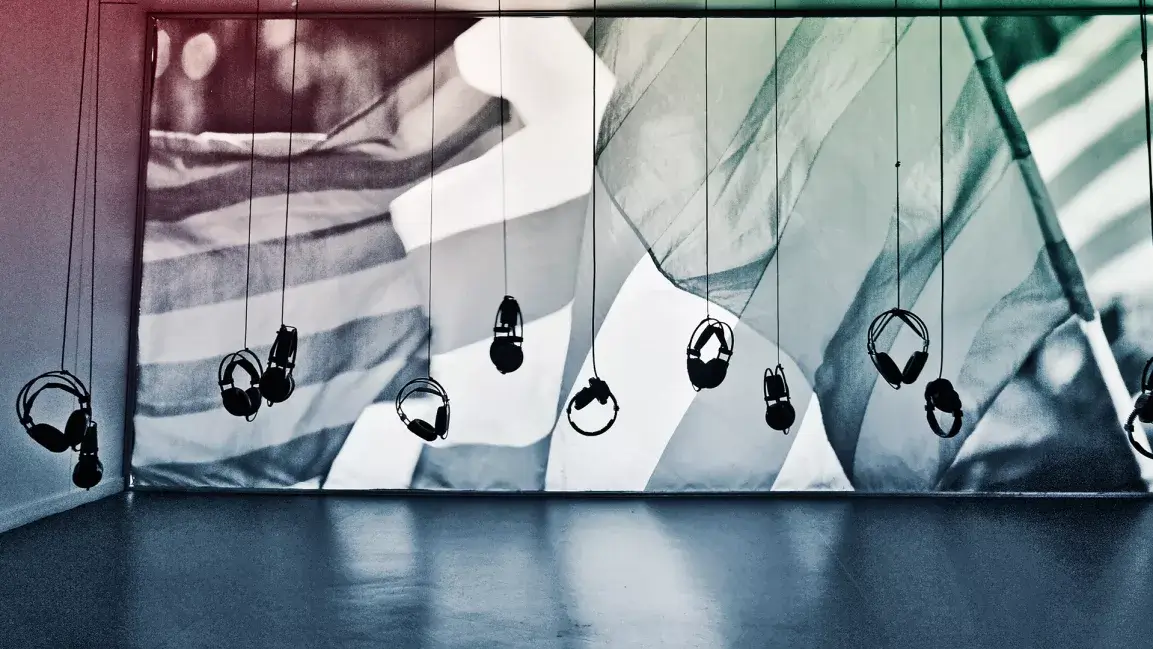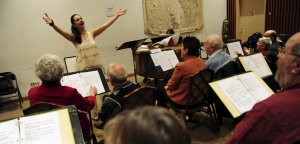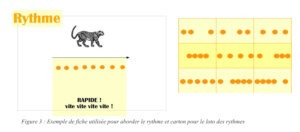Source https://www.nature.com/articles/s41598-025-02485-y
- Article
- Open access
- Published:
Rhythm training improves word-reading in children with dyslexia
- Mélanie Descamps,
- Charline Grossard,
- Hugues Pellerin,
- Claire Lechevalier,
- Jean Xavier,
- Joana Matos,
- François Vonthron,
- Catherine Grosmaitre,
- Michel Habib,
- Bruno Falissard &
- David Cohen
Scientific Reports volume 15, Article number: 17631 (2025) Cite this article
1946 Accesses
2 Altmetric
Abstract
Specific learning disorder with reading deficit (SLD-reading), or dyslexia, is one of the most common neurodevelopmental disorders. Intensive training with reading specialists is recommended, but delayed access to care is common. In this study, we tested an innovative user-friendly and accessible intervention, the medical device Mila-Learn, which is a video game based on cognitive and rhythmic training to improve phonological and reading ability. This randomized placebo-controlled trial (ClinicalTrials.gov NCT05154721) included children aged 7 to 11 y/o with SLD-reading. The children were in 2nd to 5th grade and had been in school for more than 3 years. The exclusion criteria were reading or writing remediation during the past 12 months, previous use of Mila-Learn, and severe chronic illness. The patients, who were all native French speakers, were recruited from throughout France and were randomly assigned to Mila-Learn or a matched-placebo game for an 8-week training. The primary variable was nonword decoding. The secondary variables included phonological skills, 2-min word-reading accuracy and speed, grapheme-to-phoneme conversion skills, and self-esteem. Between September 2021 and April 2023, 151 children were assigned to Mila-Learn (n = 75; male = 36; female = 39) or the placebo (n = 76; male = 42; female = 34). We registered 39 adverse events; only one was due to the protocol and was in the placebo group. We found no differences between the groups in nonword decoding in the intention-to-treat (N = 151; p = 0.39) or per-protocol analysis (N = 93; p = 0.21). However, the per-protocol analysis revealed the superiority of Mila-Learn over the placebo by 5.05 score points (95% CI 0.21; 10.3, p < 0.05) for 2-minute word-reading accuracy and by 5.44 score points (95% CI 0.57; 10.99, p < 0.05) for 2-min word-reading speed. We found no other significant effects. Mila-Learn is safe for children with SLD-reading who might benefit from this medical device.
Study registration: ClinicalTrials.gov NCT05154721-13/12/2021
Similar content being viewed by others
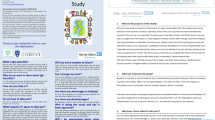
The readability of parent information leaflets in paediatric studies
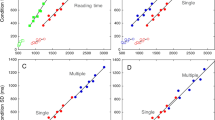
The metrics of reading speed: understanding developmental dyslexia

Identification of brain cell types underlying genetic association with word reading and correlated traits
Introduction
Specific learning disorder with impairment in reading (SLD-reading) is one of the most common neurodevelopmental disorders and affects 5–17% of school-aged children1. SLD-reading significantly impairs individuals’ academic or occupational functioning2,3. In France, support from reading specialists is recommended from the 1st grade for children with a previous or family history of language disorders or persistent difficulties in learning academic skills such as decoding or spelling despite adapted teaching and in children with a specific learning disorder4. However, the waiting list for reading therapy can be up to 18 months5, leading to late interventions, increased opportunity loss, and deviation from standard learning. The good practice guide for reading therapy recommends frequent and intensive training for managing SLD-reading, but 71% of reading specialists deliver only one session per week for these children6. In this context, there is a need for innovative user-friendly and accessible interventions.
Learning deficits in reading have been referred to as dyslexia and have been studied extensively. Among the different types of dyslexia, phonological deficits are a core feature7,8. Over the years, many authors have explored the link between temporal processing and phonological deficits observed in dyslexia9,10,11,12,13,14,15. Recently, advances in neurosciences and neuroimaging have improved the understanding of the underlying processes of SLD-reading and have offered new treatment pathways (for a review, see16). SLD-reading is closely associated with deficits in auditory and rhythmic processing. Individuals with SLD-reading exhibit atypical neural responses to sound changes, particularly in processing duration, rise time, and slow frequency modulation (FM) rates, as well as diminished amplitudes in auditory processing at the thalamic or early cortical level. Difficulties in perceiving short or rapidly varying sounds may lead to phonological deficits that affect reading and writing17. Children with SLD-reading present impaired processing of speech rhythm and temporal features, with EEG studies revealing atypical low-frequency cortical encoding of speech in the delta and theta bands (1–8 Hz), which is critical for phonological awareness18. Moreover, genetic studies highlight shared genetic underpinnings among SLD-reading, rhythm perception, and language skills. While rhythmic difficulties are also present in other neurodevelopmental disorders, dyslexic individuals demonstrate specific difficulties in rhythmic improvisation and cognitive flexibility, underscoring the importance of rhythm tracking in language development and the potential for rhythmic neural training to improve phonological and reading skills19,20.
Several studies have examined the effects of music and rhythmic training on SLD-reading1,21,22,23. A recent review examined the use of music interventions to improve reading skills in children with SLD-reading1 and focused on how music interventions target auditory processing, phonological processing, and temporal processing. The review noted that rhythmic activities were the most common musical element used in interventions and were primarily aimed at improving reading accuracy. The reviewed studies employed various music-based activities, including rhythmic perception and production, instrument playing, and singing, to enhance phonological awareness, temporal processing, and multisensory integration. Rhythmic tasks were used to improve syllable segmentation and word recognition. For example, Flaugnacco and Lopez’s24 exploratory randomized controlled trial examined the effect of 30 weeks of musical and rhythmic training in 46 children with dyslexia and reported significant improvements in phonological awareness and reading skills compared with training in painting24.
On the basis of this literature and to increase treatment availability, we developed the serious game (SG) Mila-Learn to train phonological abilities and reading in children with SLD-reading based on cognitive and rhythmic training25. Mila-Learn includes mini-games that focus on 10- to 20-minute intensive training and task repetition three to five times a week for at least three weeks, as recommended by the speech therapy good practice guide5,26. SGs aim to produce a measurable change in learning performance while preserving the motivating and ludic aspects of video games27. They represent an interesting medium to support learning in children by increasing their interest and attentional mobilization and targeting the player’s intention and effort27,28,29,30. Digital tools allow for multimodal, sequential, and simultaneous information presentation and inputs that are relevant when targeting rhythm practice. Finally, SGs offer financial and geographic accessibility. However, clinical validation of most SGs is lacking, with the notable exception of the FDA-approved Endeavor for ADHD31.
The aim of this randomized placebo-controlled trial was to evaluate the effect of 8 weeks of training with Mila-Learn on the reading ability of children with SLD-reading.
Methods
Study design
The study was a registered, multicentric, double-blinded, randomized, placebo-controlled trial (NCT05154721) conducted at the Pitié-Salpêtrière Hospital, the Henri Laborit Hospital University Centre, and the Cogcharonne Medical Centre between October 1, 2021, and March 30, 2023. The study received approval from the ethics committee of the Comité de Protection des Personnes (2021-A01709-32). All participants provided written informed consent prior to inclusion. All methods were performed in accordance with the relevant CONSORT guidelines and French regulations.
Participants
We evaluated 154 children to assess the inclusion (a diagnosis of SLD-reading through validated reading tests; being in 2nd to 5th grade of primary school; being a native French speaker or bilingual French speaker at home and having been educated for more than 3 years) and exclusion criteria (children who had undergone reading or writing remediation during the past 12 months; children who previously used Mila-Learn; and children with uncontrolled or severe chronic illness). Although the study included three sites, recruitment took place throughout France since the evaluations were conducted online (see Fig. S1 in the supplemental materials). A total of 154 children with SLD-reading were randomized and blinded to group allocation. Figure 1 shows the flow diagram of the study.
As the children were required have not participated in reading therapy interventions for the past year, most participants were out of the health care system. The participants were recruited using social media ads and an online screening questionnaire. Potential participants who met the a priori eligibility criteria were contacted by phone by the study personnel and were presented with the study, and the inclusion and exclusion criteria were evaluated. If the participant was interested and eligible, an information letter and informed consent were sent by mail. When written consent was obtained, the participant was included and randomized through an online inclusion appointment (patients were also invited to meet with the investigator onsite if desired). Randomization was centralized by an online randomization module on an electronic medium via an internet browser. The list was generated beforehand by a computer in blocks of variable size and stratified. Randomization could only occur after confirmation of inclusion to guarantee secret and unbiased allocation.
Procedure
The participants randomly received one of two serious games: Mila-Learn (the experimental group) or the placebo game (the control group). The tasks designed in the placebo game mirrored those of Mila-Learn. Each game comprised eight tasks to be completed on a touchscreen tablet. The participants were asked to play 25-min. sessions (± 20%) five times a week for eight weeks. Both games were restricted to 25-min sessions for 125 min a week. To ensure double blinding, an external clinical research organization conducted the randomization and sent a touchscreen tablet with either Mila-Learn or the placebo game to the participants. The tablets for both groups were the same and were configured only for the assessments and the study intervention.
Mila-Learn intervention: Mila-Learn is a digital medical device (EUID: 3760371850020) developed for cognitive‒musical training to improve reading ability in children aged 7 to 11 y/o with SLD-reading. It comprises a battery of musical mini-games based on rhythm repetition, synchronization, and rhythm completion in a story. The software includes a difficulty adjustment algorithm, a reward system, advanced graphic features, and original and well-known musical themes designed to maintain children’s motivation and commitment (see Fig. 2a). For the history of Mila-Learn’s conception and a detailed description, see Vonthron and Yuen25. An overview of the different games and tasks is presented in the supplementary material, Fig. S2.
Placebo intervention: The placebo game was composed of common games (tic-tac-toe games, tile matching games, stone paper scissors, colouring pages, ball-in-maze puzzle games, and bubble shooting games) designed especially for this study. To ensure placebo and double-blind allocation, the games in the placebo were matched to Mila’s environment using graphic features and characters (see Fig. 2b), and all descriptions, pictures, and older versions of Mila-Learn were removed from the internet. An overview of the different placebo games is available in supplementary material Figure S3.
Outcomes
All measures were conducted online with a reading therapist who was blinded to the group allocation. Outcomes were measured at baseline (T1), posttraining (T2) after 8 weeks of training, and at follow-up (T3) after 8 weeks without training after T2. The reading outcome measures came from two well-validated French reading tests with national norms for elementary school pupils: EVALEO27 and the Battery of Analytical Test of Written Language (BALE)33.
The primary outcome of the study was nonword decoding as measured by the absolute number of pseudowords read with the subtest pseudoword reading from EVALEO 6–1527) after 8 weeks of training (T2). The secondary outcomes after 8 weeks of training included the following variables measured at T2: (i) a descriptive evaluation of any adverse events reported by users during the 8-week training as safety criteria to assess whether the possible benefit of the medical device Mila-Learn does not occur with unwanted, harmful secondary effects; an adverse event is any untoward medical occurrence in a participant, which does not necessarily have a causal relationship with the trial intervention; (ii) an evaluation of phonological skills measured by the initial or final phoneme deletion test of the BALE28; (iii) an evaluation of reading skills in terms of speed and accuracy. This evaluation was achieved using the 2-min word list reading test of EVALEO 6–1532, which yields two scores for speed (the number of words read in 2 min) and accuracy (the number of words read correctly in 2 min); (iv) an evaluation of phoneme-to-grapheme conversion skills in terms of accuracy measured by two pseudoword transcription tests from EVALEO 6–1532; (v) self-esteem, which was evaluated with the Rosenberg Self-Esteem Scale (RSES) translated into French by Vallieres and Vallerand34. This 10-item self-questionnaire uses a 4-point Likert scale ranging from strongly agree to strongly disagree. Finally, the last secondary outcome was measured at T3 and was limited to the primary variable (non-word decoding).
Statistical analysis
The sample size of the study was determined a priori in the protocol for the hypothesis test relative to the primary outcome and was performed with G*Power 3.1.9.7. The two competing hypotheses were H0, βMila – Placebo = 0, and H1, βMila – Placebo = 0.5 (Cohen’s d35). A Cohen’s d of 0.5 is generally considered a medium effect size. Assuming a power of 85% and an α of 5%, a bilateral t test requires 73 subjects per group (i.e., a total of 146 subjects). To account for a 5% estimated dropout rate, we enrolled a total of 146/0.95 = 154 subjects.
Statistical analyses were conducted twice by an independent statistician. Data description and analysis were performed via SAS software version 9.4 and R software version 4.2.2. The maximum tolerable type-I error rate α was set at 5% in agreement with the protocol. In superiority trials, the intent-to-treat (ITT) set is used for the main analysis, whereas the per-protocol (PP) set serves as a secondary supportive analysis36. The ITT principle defines that every patient randomized should enter the primary analysis. Accordingly, patients who drop out prematurely, are non-compliant to the study treatment, or even take the wrong study treatment, are included in the primary analysis within the respective treatment group they have been assigned at randomization. This method minimizes the risk of biases. The PP analysis is conducted to identify a treatment effect that would occur under optimal conditions, such as the effect if patients are fully compliant, in our case, really exposed to the serious game (not just randomized). Accordingly, some patients from the ITT set need to be excluded from the PP sample.
Our ITT set included 151 subjects, while our PP set included participants who were exposed to SG training. This included participants who completed the study without major deviation until T2 and played “sufficiently” with the SG. We conducted analyses on both the ITT and PP datasets to answer the questions “What is the effect of assigning MILA-Learn?” and “What is the effect of using MILA-Learn?” We present the results of confirmatory analyses for both the ITT and PP sets (primary variable). We present the PP results for the exploratory analyses with the ITT results in the supplementary material, Table S1. The PP sample was more appropriate for exploratory analyses because it ensured that the participants were sufficiently exposed to the SG, especially in cases where no adverse events were reported. Notably, definitions of PP samples may be somewhat arbitrary due to factors such as adherence, motivation, and the occurrence of adverse events. In our case, the PP definition was discussed a priori to ensure exposure to the SG. We defined sufficient exposure as participants who completed the study and played at least 500 min with the SG (which corresponds to 50% of the predicted SG sessions). A key issue in PP analysis is the possible loss of the effect of randomization37.
We started by describing the Mila-Learn and placebo groups at T1. The distributions of the quantitative variables were presented as the means and standard deviations. Qualitative variables were described using absolute and relative frequencies. The main hypothesis was subsequently tested using a linear regression model with the formula “Score T2 ~ Group (Mila-Learn vs. Placebo) + Score T1 + School Grade”. Missing data in the ITT set were handled using multiple imputations (Proc MI, 10 imputations, default settings) with linear regression model variables as inputs of the imputation model. A hierarchical procedure was followed to determine the nature of the inference allowed by each secondary endpoint analysis. The secondary and exploratory hypotheses were tested using the same method, except that school grade was not included in the models, and the 95% confidence intervals and P values were obtained using bootstrap resampling (boot package, R = 100,00 replications). We chose school grade (instead of age) in the models due to a French-specific use in the school system. Children with learning impairment often repeat a school grade. Therefore, reading tests are based on norms realized by school grade rather than age, even if the two are correlated.
As said previously, the statistical plan was discussed with the French agency. It was hierarchical to maintain statistical power, meaning that we performed a limited number of statistical analyses and prioritized the primary variable. Under a hierarchical plan, when the primary variable (here word decoding) is not significant, secondary analyses are not performed and, if they are, one should consider these exploratory. The agency approved the exploratory analysis at T2 but not at T3. So, we did not show or perform any analysis at T3 other than the one on our primary variable. Similarly, some methodologists recommend regression models with statistical interaction to explore whether improvements are related to the intervention. That would be, in our case, regression models taking into account Group (Mila vs. Placebo) * Game mean duration. Regulatory agencies usually do not approve these models and are very conservative because the association between treatment and effect is not often linear, participants’ samples are often heterogeneous, meaning that some children under MILA may not improve significantly, and children under the placebo game continue to study reading at school and this may be beneficial for some of them. These assumptions are mitigated by randomization under direct comparison. That is why the agency recommended not to perform such analyses.
Role of the funding source
Researchers employed by one of the funders of the study participated in the study design, data interpretation, and writing of the report but did not participate in data collection or data curation.
Results
One hundred fifty-four patients were included in the study and were randomized into the experimental or control group. Before T1, two patients withdrew their consent, and hearing problems were detected in one patient. A total of 151 patients were included in the ITT analysis (see flow chart, Fig. 1). The PP sample included participants who completed the study without major deviation until T2 and played at least 500 min. Eight patients were excluded from the PP population because of major deviations in the T2 evaluation delay, and 33 participants played less than half the time recommended (i.e., less than 500 min). Table 1 presents the baseline characteristics of both groups at baseline (T1) in the ITT and PP samples.
The primary outcome was improvement in pseudoword reading at 8 weeks of training (T2). The scores at baseline and T2 are shown in Table 2 (first line). The linear regressions did not reveal a significant difference between groups in the ITT sample (p = 0.39) or the PP sample (p = 0.21). In terms of safety, 39 adverse events (AEs) were declared for 29 children during the study. Adverse event declaration encompasses any medical condition or symptom occurring during the study (e.g., covid-19, car accident, otitis, headache). Each adverse event was assessed by the investigator to determine the intensity, cause/triggering factor, seriousness, actions, relation with the protocol. Only one AE was related to the study protocol and occurred in the placebo group (Table 3). The child presented with headache after using the touchscreen tablet.
We present the results of the PP analyses in the paper and the ITT analyses in the supplemental materials, Annex 1. Table 2 summarizes the secondary measures at baseline and after 8 months of training (T2) for the PP sample. Linear regression on 2-min word reading accuracy scores revealed that the participants improved significantly more with Mila-Learn than with the placebo. After 8 weeks, the improvement in accuracy was 5.05 points greater on average than with the placebo (95% CI 0.2 1–10.3; p = 0.046). Linear regression on 2-min word reading speed scores revealed that the participants improved significantly more with Mila-Learn than with the placebo. After 8 weeks, the improvement in speed was 5.44 points greater on average than the improvement with the placebo (95% CI 0.57–10.99; p = 0.037). With regard to phonological skills, we found a statistical tendency in favour of Mila-Learn (p = 0.1). The models revealed no significant difference in nonword spelling scores or self-esteem. Finally, the linear regressions on pseudoword readings 8 weeks after the end of training (T3) did not reveal a significant difference between the groups (p = 0.346).
Discussion
This study presents the results of a randomized controlled trial that measured the effect of 8 weeks of training with Mila-Learn on the reading ability of children with SLD-reading. To our knowledge, this is the first clinical trial to evaluate the effect of a digital medical device on SLD-reading. Overall, the study results revealed that Mila-Learn was safe to use, produced significant improvement in word reading, and demonstrated a trend in phonological awareness. Differences in nonword decoding, spelling, and self-esteem were not detected between the groups.
Our primary criterion was nonword decoding, which measures the ability to decode nonwords quickly and accurately by applying the rules of phonetics. Unexpectedly, the results revealed no differences between the groups in the ITT or PP analysis or after a 2-month follow-up. Nonword decoding is a measure that serves as an indicator of grapheme-phoneme conversion skills given that pseudowords cannot be memorized or recognized globally and must be phonetically decoded7. The test, EVALEO, is a commonly used tool in clinical practice with strong sensitivity that enables clinicians to distinguish dyslexic readers from readers without dyslexia. The scores can be divided into seven classes, with only one class revealing a pathological score. Changes in low scores are therefore difficult to objectively determine as the tool is mostly clinically oriented and has low sensitivity to change32. It is also possible that 8 weeks of training may be too short to reveal an effect or that rhythmic training alone is not sufficient to facilitate decoding and must be combined with grapheme-phoneme training5 and attention skills training38.
SLD-reading manifests as severe and persistent difficulties in reading fluency and accuracy, typically characterized by slow, effortful reading and substantial inaccuracies1. Reading accuracy precedes the development of reading speed, with significant improvements in speed occurring once a foundational accuracy level (approximately 70%) is established39. Consequently, reading improvement is difficult to assess since it can be expressed in terms of accuracy, fluency, or both. Nevertheless, the analysis of word reading revealed significant benefits to both reading accuracy and speed for children with SLD-reading using Mila-Learn compared with the placebo. This result is in line with previous research that shows benefits for word reading after musical and rhythmic training compared with art classes1,24 and suggests that musical and rhythmic training remains relevant in digitalized settings. Moreover, in contrast to Flaugnacco et al.24, our sample included children with neurodevelopmental comorbidities such as speech and language disorders, attention-deficit/hyperactivity disorder, and developmental coordination disorders, which represent the majority of SLD presentations7. Notably, despite the improvement in reading accuracy, we found no effect on spelling or self-esteem, indicating that the learning impact on SLD remains significant.
Recent research in the neurosciences has revealed links among speech, language processing, and brain oscillation40. Stimulus–brain alignment results from auditory and motor tuning throughout language development and constitutes a natural model system of how neural oscillatory activities affect human cognition41,42. A temporal sampling of speech by neuroelectric oscillations that encode incoming information at different frequencies could explain the perceptual, rhythmic and phonological difficulties found in individuals with SLD-reading40. These may constitute a biomarker and another proxy of phonological/segmentation impairment. Specific oscillatory activities have been associated with both phonological processing and SLD-reading39. Although speech and music have slightly different structured rhythms44, we considered whether an SG such as Mila-Learn could also affect brain oscillatory activity in children with SLD-reading. A study of kindergarten children at risk of SLD-reading is currently ongoing.
Despite the educative agenda, low cost, and accessibility of SGs, no SG, with the exception of the FDA-approved Endeavor® for ADHD, has achieved clinical validation31. In this context, more research on Mila-Learn is needed. In addition to the positive effect on reading found in the current study, we need to understand the best use of Mila-Learn in clinical practice. Should it be used for children with SLD-reading on a waiting list, as an add-on intervention to conventional care, or as a drop-off for speech therapy to capitalize on the attractiveness of gaming to children to promote motivation?
In addition to the strengths of this study, such as randomization, the quality of the placebo game to maintain blinding, and the sample size, the main limitation of the findings is the lack of significant results in the ITT analysis, which was the primary analysis in the protocol. The choice of ITT over PP analysis was a regulatory requirement of the French authority to discuss approval in the future. ITT is the gold standard in drug trials, but we believe it is not as relevant for SGs. Indeed, drug approvals are based on both efficacy and tolerability, which are best captured by ITT. Nevertheless, the tolerability of SG was excellent. Therefore, the PP sample was more appropriate for exploratory analyses because it ensured that the participants were sufficiently exposed to the SG in both groups. Interestingly, in the field of education, Pasquelletto et al. reported enhanced reading skills in children using the video game “Skies of Manawak”, which trained attention and executive function. Their analysis included children who played at least 90% of the planned sessions with the game38. However, we are aware that PP samples might mitigate the effect of randomization. In our case, this eventuality appeared limited as baseline characteristics of the two PP group appeared similar, as well as the number of patients per groups included in the PP (see Table S2 supplementary material). A second limitation is the lack of understanding of the mechanisms involved since our primary hypothesis on phonological awareness was not supported. In the future, it is necessary to address the inclusion of children with other neurodevelopmental disorders (NDD) and to assess processing speed and visual-attentional problems that are important in learning to read7. Although we included a placebo-serious game in the control group, we cannot exclude the possibility that Mila-Learn was more attractive to children with ADHD characteristics.
Recent recommendations regarding the care of children with dyslexia emphasize the need for personalized training based on the profile of each child. Further studies could involve the collection of more information about the children, such as their musical training, or comparisons of the impact of the training relative to the strengths or weaknesses of the children, such as their phonological or visual-attentional skills. However, the diverse profiles of the recruited children make our sample more representative of the diversity of children with SLD-reading. Finally, there is a need to assess the impact of the training on children in a more ecological manner. We did not assess the reading of short texts, which prevented us from evaluating the children’s reading comprehension.
In conclusion, this randomized controlled trial investigated the effects of musical training on reading ability in children with SLD-reading. Despite the primary outcome measure not yielding the expected results, the findings on the secondary analysis of the PP samples support the safety and beneficial effects of the Mila-Learn digital medical device in terms of word-reading accuracy and speed. Further studies are warranted to identify evidence-based criteria for approval. Specifically, a second large RCT should be conducted to confirm the results for reading accuracy and speed and the promising results regarding phonological awareness. It is also necessary to evaluate children’s reading comprehension and ensure an increase in the use of the training device. In addition, the device could be improved to target other abilities affected by SLD-reading, such as spelling. Given that rhythmic difficulties can be found in other neurodevelopmental disorders, the use of Mila-Learn could be explored for individuals with other NDDs, such as ADHD or language disorders.
Data availability
The data that support the findings of this study are not openly available due to reasons of sensitivity (vulnerable participants) and are available from the corresponding author upon reasonable request.
References
Lewis, J. D. & Kim, S. J. Scoping review of music interventions aimed at improving reading skills in children with specific learning disorders in reading. J. Music Ther. thae010 (2024).
APA. Diagnostic and Statistical Manual of Mental Disorders: DSM-5, 5th ed. xliv, 947 (American Psychiatric Association, 2013).
Organization, W. H. ICD-11: International classification of diseases 2022 [11th revision] https://icd.who.int/
HAS. Comment améliorer le parcours de santé d’un enfant avec troubles spécifiques du langage et des apprentissages. (2018).
ARS-Normandie. Rapport de diagnostic territorialisé de l’offre en faveur des enfants et adolescents avec des troubles spécifiques du langage et des apprentissages. (2017).
CFO. Recommandations De Bonne Pratique d’Evaluation, De Prévention Et De Remédiation Des Troubles Du Langage Écrit Chez L’enfant Et L’adulte (Collège Français d’Orthophonie, 2022).
Peterson, R. L. & Pennington, B. F. Developmental dyslexia. Lancet. 379 (9830), 1997–2007 (2012).
Share, D. L. Common misconceptions about the phonological deficit theory of dyslexia. Brain Sci. 11(11). (2021).
Begel, V. et al. Rhythm as an independent determinant of developmental dyslexia. Dev. Psychol. (2022).
Corriveau, K. H. & Goswami, U. Rhythmic motor entrainment in children with speech and Language impairments: tapping to the beat. Cortex 45 (1), 119–130 (2009).
Gooch, D., Snowling, M. & Hulme, C. Time perception, phonological skills and executive function in children with dyslexia and/or ADHD symptoms. J. Child. Psychol. Psychiatry. 52 (2), 195–203 (2011).
Goswami, U., Huss, M., Mead, N., Fosker, T. & Verney, J. P. Perception of patterns of musical beat distribution in phonological developmental dyslexia: significant longitudinal relations with word reading and reading comprehension. Cortex 49 (5), 1363–1376 (2013).
Hande, V. & Hegde, S. Deficits in musical rhythm perception in children with specific learning disabilities. NeuroRehabilitation 48 (2), 187–193 (2021).
Huss, M., Verney, J. P., Fosker, T., Mead, N. & Goswami, U. Music, rhythm, rise time perception and developmental dyslexia: perception of musical meter predicts reading and phonology. Cortex 47 (6), 674–689 (2011).
Wolff, P. H. Timing precision and rhythm in developmental dyslexia. Read. Writ. 15, 179–206 (2002).
Habib, M., Salminen, J. A. & Leppänen, H. K. The neurological basis of developmental dyslexia and related disorders: a reappraisal of the temporal hypothesis, twenty years on. Brain Sci. 11(6) (2021).
Hämäläinen, P. H. Basic auditory processing deficits in dyslexia: systematic review of the behavioral and event-related potential/field evidence. J. Learn. Disabil. 46(5), 413–427 (2013).
Araújo, J. et al. Atypical low-frequency cortical encoding of speech identifies children with developmental dyslexia. Front. Hum. Neurosci. 18, 1403677 (2024).
Alagöz, G. et al. The shared genetic architecture and evolution of human Language and musical rhythm. Nat. Hum. Behav. 1–15 (2024).
Bégel, V., Dalla Bella, S., Devignes, Q., Vandenbergue, M., Lemaître, M. P. & Dellacherie, D. Rhythm as an independent determinant of developmental dyslexia. Dev. Psychol. 58 (2), 339 (2022).
Chobert, J., Francois, C., Velay, J. L. & Besson, M. Twelve months of active musical training in 8- to 10-year-old children enhances the preattentive processing of syllabic duration and voice onset time. Cereb. Cortex. 24 (4), 956–967 (2014).
Gordon, R. L., Fehd, H. M. & McCandliss, B. D. Does music training enhance literacy skills? A meta-analysis. Front. Psychol. 6, 1777 (2015).
Habib, M. et al. Music and dyslexia: A new musical training method to improve reading and related disorders. Front. Psychol. 7, 26 (2016).
Flaugnacco, E. et al. Music training increases phonological awareness and reading skills in developmental dyslexia: A randomized control trial. PloS One. 10 (9), e0138715 (2015).
Vonthron, F., Yuen, A., Pellerin, H., Cohen, D. & Grossard, C. A serious game to train rhythmic abilities in children with dyslexia: feasibility and usability study. JMIR Serious Games. 12, e42733 (2024).
Suggate, S. P. A meta-analysis of the long-term effects of phonemic awareness, phonics, fluency, and reading comprehension interventions. J. Learn. Disabil. 49 (1), 77–96 (2016).
Mayer, R. E. Computer Games for Learning: an evidence-based Approach (The MIT Press, 2014).
Algahtani, S. S. Technology-based interventions for children with reading difficulties: a literature review from 2010 to 2020. Educ. Tech. Res. Dev. 68, 3495–3525 (2020).
Oldrati, V. et al. Effectiveness of computerized cognitive training programs (CCTP) with Game-like features in children with or without neuropsychological disorders: a Meta-Analytic investigation. Neuropsychol. Rev. 30 (1), 126–141 (2020).
De Cara, B. & Plaza, M. Les outils informatisés d’aide à La lecture: Un Bilan des recherches. ANAE 107, 184–190 (2010).
EndeavorRx® World’s First and only Prescription Video Game Treatment, Secures FDA Label Expansion for Pediatric ADHD Patients Aged 13–17 [press release]. Boston: Buisness Wire.
Launay, L., Maeder, C., Roustit, J. & Touzin, M. EVALEO: Evaluation du langage écrit et du langage oral 6–15 ans.2018.
Jacquier-Roux, M., Lequette, C., Pouget, G., Valdois, S. & Zorman, M. Batterie Analytique Du Langage Ecrit (BALE, 2010).
Vallieres, E. F. & Vallerand, R. J. Traduction et validation Canadienne-Française de L’échelle de L’estime de Soi de Rosenberg. Int. J. Psychol. 25 (2), 305–316 (1990).
Cohen, J. Statistical Power Analysis for the Behavioral Science (Routledge, 1988).
Tripepi, G., Chesnaye, N. C., Dekker, F. W., Zoccali, C. & Jager, K. J. Intention to treat and per protocol analysis in clinical trials. Nephrol. (Carlton). 25 (7), 513–517 (2020).
Smith, V. A., Coffman, C. J. & Hudgens, M. G. Interpreting the results of Intention-to-Treat, Per-Protocol, and As-Treated analyses of clinical trials. JAMA 326 (5), 433–434 (2021).
Pasqualotto, A. et al. Enhancing reading skills through a video game mixing action mechanics and cognitive training. Nat. Hum. Behav. 6, 545–554 (2022).
Juul, H., Poulsen, M. & Elbro, C. Separating speed from accuracy in beginning reading development. J. Educ. Psychol. 106 (4), 1096–1106 (2014).
Goswami, U. A temporal sampling framework for developmental dyslexia. Trends Cogn. Sci. 15 (1), 3–10 (2011).
Gross, J. et al. Speech rhythms and multiplexed oscillatory sensory coding in the human brain. PLoS Biol. 11 (12), e1001752 (2013).
Giraud, A. L. & Poeppel, D. Cortical oscillations and speech processing: emerging computational principles and operations. Nat. Neurosci. 15 (4), 511–517 (2012).
Schwarz, J., Lizarazu, M., Lallier, M. & Klimovich-Gray, A. Phonological deficits in dyslexia impede lexical processing of spoken words: linking behavioural and MEG data. Cortex 171, 204–222 (2024).
Ding, N. et al. Temporal modulations in speech and music. Neurosci. Biobehav Rev. 81 (Pt B), 181–187 (2017).
Acknowledgements
We are grateful to the patients, their parents and health professional from Hôpital de la Pitié-Salpêtrière, Hôpital Henri Laborit and Clinique CogCharonne for participating in this research. We thank the association Fédération Française des troubles dys (FFDys) especially Nathalie Groh and Laëtitia Branciard for support in study recruitment and advice, Yves Brault and Jennifer Zuk for methodological fruitful discussion. Finally, we would like to thank Marie-Laure Chleq as well as the artistic and developers’ team from POPPINS, who created the serious game: Sébastien Desarmaux, Didier Bazoge, Antoine Yuen, Xavier Réquillart, Gaël Miot, Antony Sirac, Théophile Demarcq, Nicolas Bara and Laurine Vire.
Funding
This project was financed by the French government as part of two programmes, the Recovery Plan (Plan de Relance) and the Investment for the Future programme (Programme d’Investissements d’Avenir), and bMotion Technologies.
Study registration: ClinicalTrials.gov NCT05154721–13/12/2021.
Ethics: Comité de Protection des Personnes Ile de France IV (2021-A01709-32), approval on 13/08/2021.
Author information
Mélanie Descamps and Charline Grossard contributed equally to this work.
Authors and Affiliations
bMotion Technologies, Paris, France
Mélanie Descamps & François Vonthron
Institut des Systemes Intelligents et Robotiques, Sorbonne Université, Paris, France
Charline Grossard & David Cohen
Service de Psychiatrie de l’Enfant et de l’Adolescent, APHP, Groupe Hospitalier Pitié-Salpêtrière, Paris, France
Charline Grossard, Hugues Pellerin, Joana Matos & David Cohen
Pôle Universitaire de Psychiatrie de l’Enfant et de l’Adolescent, Centre Hospitalier Spécialisé Henri Laborit, Poitiers, France
Claire Lechevalier & Jean Xavier
CNRS UMR 7295, Equipe CoCliCo, Centre de Recherches sur la Cognition et l’Apprentissage, Poitiers, France
Claire Lechevalier & Jean Xavier
Reference Centre of Language and Learning Disorders, Hôpital Necker-Enfants Malades, APHP, Paris, France
Catherine Grosmaitre
Laboratoire DysCo, Université de Nanterre, Nanterre, Paris, France
Catherine Grosmaitre
Cognitive Neuroscience Laboratory, Neurodys Institute, Aix-Marseille University, UMR 7291, Marseille, France
Michel Habib
Faculté de médecine Paris-Saclay, Le Kremlin-Bicêtre, France
Bruno Falissard
Centre de recherche en épidémiologie et santé des populations de l’INSERM, Paris, France
Bruno Falissard
Contributions
Funding acquisition: FV; conceptualization and methodology: DC, ChG, CaG, MH, BF, FV; investigation: DC, ChG, CaG, JX, JM, CL; formal analysis: HP, BF; writing – original draft: MD, DC; writing – review and editing: CaG, ChG, HP, JX, CL, FV, MH. All authors have read and agreed to the published version of the manuscript.
Corresponding author
Correspondence to David Cohen.
Ethics declarations
Competing interests
DC, ChG, MH, BF, HP, JM, JX and CL have no conflict of interest to declare. MD is employed full-time as lead of scientific affairs at Poppins. FV is Poppins’ CEO. CaG is an expert consultant for Poppins. To mitigate conflict of interest, clinical sites were independent, a study management plan including a data management and monitoring plan as well as a statistical analysis plan were designed in advance. The data review was blinded. Interpretation of results has been realized during a scientific board of specialists including psychiatrists, speech therapists, neuropsychologists, and statisticians.
Additional information
Publisher’s note
Springer Nature remains neutral with regard to jurisdictional claims in published maps and institutional affiliations.
Electronic supplementary material
Rights and permissions
Open Access This article is licensed under a Creative Commons Attribution-NonCommercial-NoDerivatives 4.0 International License, which permits any non-commercial use, sharing, distribution and reproduction in any medium or format, as long as you give appropriate credit to the original author(s) and the source, provide a link to the Creative Commons licence, and indicate if you modified the licensed material. You do not have permission under this licence to share adapted material derived from this article or parts of it. The images or other third party material in this article are included in the article’s Creative Commons licence, unless indicated otherwise in a credit line to the material. If material is not included in the article’s Creative Commons licence and your intended use is not permitted by statutory regulation or exceeds the permitted use, you will need to obtain permission directly from the copyright holder. To view a copy of this licence, visit http://creativecommons.org/licenses/by-nc-nd/4.0/.
About this article
Cite this article
Descamps, M., Grossard, C., Pellerin, H. et al. Rhythm training improves word-reading in children with dyslexia. Sci Rep 15, 17631 (2025). https://doi.org/10.1038/s41598-025-02485-y
Received
Accepted
Published
DOIhttps://doi.org/10.1038/s41598-025-02485-y
Share this article
Anyone you share the following link with will be able to read this content:
Provided by the Springer Nature SharedIt content-sharing initiative
